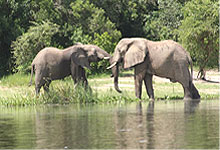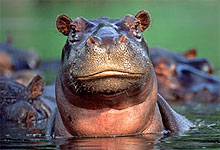Murchison
Falls National Park —
Uganda
(Murchison
Falls National Park is the largest National Park in
Uganda - covering an area of 3,840 sq km. Murchison
Falls National Park lies at the core of the greater
Murchison falls conservation Area, which also embraces
the Bugungu and Karuma wildlife reserves as well as
the Budongo forest.)
 Murchison
Falls in Uganda
Murchison
Falls in Uganda |

Elephants
in Murchison
Falls |
 Hippos
at Murchison
Falls Hippos
at Murchison
Falls |
Murchison
Falls National Park Uganda
Murchison
Falls National Park View
Rates, Discounted Prices - Book & Save Now!
Murchison
Falls National Park is one of Uganda's best
safari parks for game viewing safaris and birding
tours. Together with Kaniyo Pabidi and Budongo Forest,
Murchison Falls is an important destination for primate
safaris most especially chimpanzee tracking safaris.
All
travelers heading to Murchison Falls from Kampala
must first drive to Masindi which actually takes about
3 hours. This is the only public means of transport
from Kampala to Masindi town. They then proceed to
Murchison falls National Park for another 3 hours
making a total of 6 hours.
A
4WD vehicle is recommended on the Masindi-Paraa section
of the road. The park can be reached by air charter
services. There are airstrips at Rabongo and Pakuba
which can hold up to six seater light aircraft.
The
Murchison Falls National Park lies at the northern
end of the Albertine Rift Valley, where the bulky
Bunyoro escarpment merges into the vast plains of
Acholiland. Murchison Falls is one of Uganda's oldest
conservation areas, it was initially gazetted as a
game reserve in 1926 to protect a savanna that Winston
Churchill described in 1907 as 'Kew Gardens and the
zoo combined on an unlimited scale'.
During
Idi Amin's 15-year despotic rule of Uganda in the
1970's, the country's wildlife was almost wiped out
by wayward soldiers using animals as target practice.
Now 40 years on and in times of peace, Uganda is once
again teeming with wildlife in national parks well
worth visiting.
In
the north-west of Uganda the Nile River's rapidly
flowing course is rudely interrupted by a narrow fissure,
which forces this mighty river through a gap just
24 feet (7 meters) wide. In a furious demonstration
of power the water explodes into the deservedly named
'Boiling Pot'.
Then
at the height of its anger, the river corkscrews through
another small gap to cascade 120 feet (36½
metres) in a thunderous foaming torrent.
Impressive
for power rather than size, the Murchison Falls are
a spectacular sight. However, there is much more to
the park than a frothing river. There is a diversity
of habitats both riverine and on grassy plains and
savannah woodlands. Altitudes vary from 1,650-4,240
feet above sea level (500-1,292 meters).
2
Days/ 1 Night Murchison Falls National Park
Safari |
|
Murchison
Falls National Park, Uganda Accommodations |
|
Click Here |
Animals
& Birds of Murchison Falls National Park
The
Nile River calms itself after the falls into a rather
more gentile flow and the best way to experience the
abundance of animal and bird life along its banks
is on a riverboat from Paara Lodge.
The
river is full of unbelievably large Nile crocodiles
who sunbathe on rocks and display their entire 15-foot
(4½ metre) reptilian bodies.
Occupying
the same waterway are thousands of pink-eared hippos
who take defending their territories seriously and
can startle you with a sudden mock charge.
Buffaloes
wade nonchalantly through the prolific floating water
hyacinth fringing the banks, and huge herds of over
100 elephants cool themselves in shallow creeks and
graze silently on the lush grasses. The park is also
home to giraffe, oribi, hartebeest, waterbuck and
Uganda kob.
The park is dominated by savanna, woodland, river/
wetland and tropical forest habitats which provide
homes for 76 mammal species and 450 bird species.
Large mammals include lion, leopard, elephant, hippopotamus,
Rothschild's giraffe; Cape buffalo, hartebeest, oribi,
warthog, and Uganda kobo.
The Nile corridor provides year-round water for these
animals as well as a plethora of water birds (including
the rare shoebill stork) and Uganda's largest population
of Nile crocodile. The Kaniyo Pabidi forest provides
refuges for chimpanzee and other primates as well
as an impressive 360 species of bird.
During
the boat excursion your senses are bombarded with
such diversity, it is hard to know where to look.
It is a bird spotters paradise and is especially good
for seeing the bizarre looking and very rare shoebill
(or whale-headed) stork.
It
stands alone four-feet high (over 1 meter), with a
head like a wobbly wooden mallet and a timid pouting
expression. It is almost matched in height by the
goliath heron, who appears elegant in comparison.
Murchison
Falls Park Highlights
Dry Season
June
to September is the driest time when most animals
remain near water, but be prepared for afternoon thunderstorms
at any time. The hot dry time is January to February
and is a good time to visit. Dry season temperatures
average 80°F (25°C).
Rainy Season
It
rains anytime from October to December and March to
May when many roads become impassible
Murchison
Falls National Park Facts
*
The national parks covers 600 miles² (1,500 km²)
*
The park is accessible on a tarmac road from the capital
city Kampala. The journey takes six hours
* The Nile's flow is dam regulated so the water levels
remain more or less constant throughout the year
